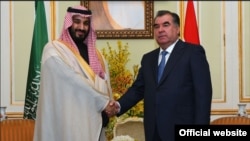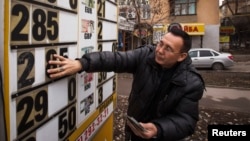
Usually, when Tajik President Emomali Rahmon visits Saudi Arabia the trip does not generate much news outside of Tajikistan. But Rahmon's January 2-4 visit, though it was undoubtedly planned months in advance, came as both Tajikistan and Saudi Arabia found themselves in fresh disputes with Iran.
Reports about the official portion of Rahmon's visit to Saudi Arabia mention a meeting with Saudi King Salman, the signing of new bilateral agreements, and discussions about combating terrorism, extremism, narcotics trafficking, and transnational criminal organizations.
The word "Iran” is absent from these reports, though it was surely on the minds of Tajik and Saudi officials, and Rahmon's visit to Saudi Arabia was likely something officials in Iran were watching closely as well.
Tajik-Iranian ties have been good for many years, in part because Iran sees Tajikistan as a natural gateway for Iranian policies in Central Asia. But at the end of December, Iran invited the leader of the recently banned Islamic Renaissance Party of Tajikistan (IPRT), Muhiddin Kabiri, to attend an international conference on Islamic unity in Tehran. Kabiri had fled Tajikistan months before, as it became clear the Tajik government was intent on closing the party. Since his departure, Tajik authorities have accused the IRPT leader of attempting to overthrow the government.
At the conference in Tehran, Kabiri was seated next to the head of Tajikistan's state-backed Islamic Council. Iranian Supreme Leader Ayatollah Ali Khamenei met with Kabiri on the sidelines of the conference.
Kabiri's presence at the event drew sharp criticism from Tajikistan. The Tajik Foreign Ministry released a statement on December 29 saying it was "greatly concerned” that the leader of an "extremist and terrorist” organization was invited to the conference. Tajikistan's chief mufti, Sayidmukarram Abdulkodirzoda, spoke about Iran during Friday prayers on January 1, saying Iran had always claimed to be Tajikistan's friend but "at the conference we saw that Iran clearly showed disrespect to the Tajik nation and government.”
Saudi Arabia's recent trouble with Iran has been well publicized. The execution of one of Saudi Arabia's leading Shi'ite clerics, Sheikh al-Nimr, on January 2 sparked protests in Iran, including the torching of the Saudi Embassy in Tehran. The next day, while Rahmon in Riyadh, Saudi Arabia cut its ties to Iran.
For Saudi Arabia, the Rahmon visit was an opportunity to dampen Iran's relations with Tajikistan, a country with which Tehran maintained excellent ties even as it came under international sanctions and was considered an international pariah. Prying such a good ally away from Iran would suit the Saudi government, which has warned about what it sees as growing Iranian influence in neighboring Iraq, Syria, and Yemen.
For Tajikistan, Rahmon's visit -- which concluded with a pilgrimage to Mecca -- was a timely reminder to Tehran that Tajikistan has other friends in the Islamic world; friends in the Arab world.
Saudi Arabia pledged to provide some $108 million through the Islamic Development Bank (IDB) for the construction of major roads in the poorly connected eastern Tajikistan. It was pocket change for Saudi Arabia, but seeing as the IDB allocated only some $84 million to Tajikistan from 2002 until 2015, Rahmon came away from the trip with something more than usual.
Probably a few people remembered during Rahmon's visit that the majority of Tajikistan's people are Sunni Muslims, as in Saudi Arabia, not Shi'a, as in Iran. That fact has always tempered Tajikistan's relations with the Iranian regime.
Saudi-Iranian ties have been bad for some time now and are likely to remain so. But Tajikistan cannot afford to engage in political brinksmanship with Iran for long. Dushanbe needs Tehran.
When calling Iran an "accomplice to traitors” in last Friday's sermon, Tajik Mufti Abdulkodirzoda noted the linguistic and cultural affinities that helped Tehran forge ties with Dushanbe since the early days of Tajikistan's independence. Iran used those similarities to also gain an economic foothold in Tajikistan.
Iran is helping complete the Anzob or Istiqlol Tunnel (far behind schedule and dubbed by some the "tunnel of death”) to better connect northern and southern Tajikistan by road.
More importantly, Iran invested some $180 million, and endured countless objections from Uzbekistan, to help build Tajikistan's Sangtuda-2 hydropower plant, which has already become an indispensable supply of electricity for Tajikistan.
However, Iran retains ownership of Sangtuda-2 until about 2029 under a "BOOT” (Buy-own-operate-transfer) deal and that hinges on Tajikistan repaying the Iranian investment. Currently, both Sangtuda-2 and the Russian-built Sangtuda-1 hydropower plant are tens of millions of dollars in debt.
Iran has invested in many other projects in Tajikistan and, in return, Dushanbe has backed Tehran in international disputes, such as Iran's right to have nuclear power.
The Tajik government's strong reaction to Kabiri's attendance at the conference in Tehran is somewhat surprising.
Iran was one of the main players in arranging talks between the Tajik government and the United Tajik Opposition (UTO) during Tajikistan's 1992-97 civil war. The IRPT was the backbone of the UTO and IRPT leaders sheltered in Iran during much of the war. The peace accord Iran helped broker included providing the Tajik opposition, including the IRPT, with places in the Tajik government.
That deal unofficially ended when, after nearly 18 years, the IRPT lost its last places in the government after the March 2015 parliamentary elections that some feel were rigged by the Tajik government.
Iranian officials reacted to Tajikistan's complaints by pointing out Kabiri and his party had been invited to Islamic Unity conferences in years past, before the IRPT was banned and declared an extremist group by Tajik authorities.
Tajikistan's position in world politics is not good at the moment. Western interest in the region is on the wane, while Russia and China appear interested in Central Asia but their domestic economic situations preclude significant investment or attention in the near future.
Iran is a different position. With sanctions on exports of Iranian oil and gas expected to be lifted soon, Tehran will receive a lot of attention and offers, making this an inopportune time for Tajikistan to aggravate a relationship that for nearly 25 years has benefitted both countries.








